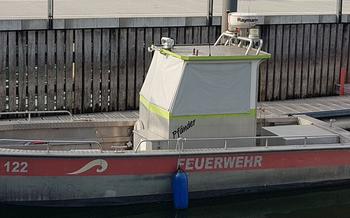
Hangar 7 Collection of Historical Aircraft
- Hallein and Hangar 7: A Unique Destination
- The Flying Bulls: A Celebrated Aviation Team
- A Treasure Trove of Historical Aircraft
- Boeing Stearman Model 75: A Timeless Classic
- Republic P-47 Thunderbolt: A Powerful Warbird
- Grumman HU-16 Albatross: A Versatile Amphibian
- North American P-51 Mustang: A Symbol of Freedom
- Yakovlev Yak-52: A Soviet Classic
- Zlin Z-50: A Czech Masterpiece
- Fieseler Fi 156 Storch: A Remarkable STOL Aircraft
- Insider Tip: The Hangar 7 Experience
Hallein and Hangar 7: A Unique Destination
Hallein, a picturesque town nestled in the Austrian Alps, is home to a remarkable aviation gem: Hangar 7, a stunning architectural masterpiece that houses a world-renowned collection of historical aircraft.
Established in 2003 by Red Bull co-founder Dietrich Mateschitz, Hangar 7 epitomizes the fusion of aviation and art. Its awe-inspiring design, reminiscent of a modern cathedral, features a glass-and-steel structure that blends seamlessly with the surrounding landscape.
Beyond its architectural significance, Hangar 7 is the home base of the Flying Bulls, an acclaimed aviation team dedicated to preserving and showcasing aviation history.
The collection of historical aircraft at Hangar 7 is a testament to the passion and dedication of the Flying Bulls. From rare and iconic models to meticulously restored warbirds, each aircraft tells a unique story of aviation's rich past.
Hangar 7 offers visitors an immersive experience, combining aviation history with contemporary art and innovative technology. Guided tours provide insights into the stories behind the aircraft, while interactive exhibits and multimedia displays engage visitors of all ages.
Whether you're an aviation enthusiast, a history buff, or simply seeking a unique cultural experience, Hangar 7 is a must-visit destination that promises to ignite your imagination and leave you in awe.
The Flying Bulls: A Celebrated Aviation Team
The Flying Bulls are a renowned aviation team based in Austria, dedicated to preserving and celebrating aviation history. Founded in 1999 by Dietrich Mateschitz, the team's mission is to acquire, restore, and fly historically significant aircraft, showcasing them to the public and inspiring future generations of aviators.
Their accomplishments include record-breaking flights, participation in air shows worldwide, and the establishment of the Flying Bulls Academy, which offers flight training and aerobatic courses. The team's passion for aviation history is evident in their meticulous restoration projects, bringing iconic aircraft back to life and ensuring their legacy continues to soar.
Hangar 7 serves as the home base for the Flying Bulls, providing a unique setting for their aircraft collection and a hub for aviation enthusiasts. The team's dedication to preserving aviation heritage and sharing it with the world has earned them international recognition and a reputation as one of the leading aviation teams in Europe.
A Treasure Trove of Historical Aircraft
Hangar 7 houses an impressive collection of historical aircraft, each with its unique story. The diversity of the collection is captivating, with planes ranging from vintage biplanes to powerful jet fighters. Some of the highlights include a Boeing Stearman Model 75, a Republic P-47 Thunderbolt, a Douglas DC-6B, a Grumman HU-16 Albatross, a B-25 Mitchell, a North American P-51 Mustang, a Lockheed T-33 Shooting Star, a Yakovlev Yak-52, a Zlin Z-50, a Fieseler Fi 156 Storch, and a Heinkel He 1
These aircraft are not just exhibits; they are meticulously restored and maintained in flying condition. The passion and dedication of the Flying Bulls team shine through in the pristine condition of the planes. Visitors can admire the intricate details, the gleaming paintwork, and the powerful engines of these remarkable machines.
The collection is not only a feast for the eyes but also a valuable source of aviation history. Each aircraft represents a significant chapter in the evolution of flight, from the early days of aviation to the jet age. Visitors can learn about the people who designed, built, and flew these planes, and the incredible stories of their adventures in the air.
Hangar 7 is a treasure trove for aviation enthusiasts, a place where history comes alive. Whether you are a seasoned pilot, a curious history buff, or simply someone who appreciates the beauty and wonder of flight, the Hangar 7 collection is sure to leave you in awe.
Boeing Stearman Model 75: A Timeless Classic
The Boeing Stearman Model 75, a legendary aircraft that has captured the hearts of aviation enthusiasts worldwide, holds a prominent place within Hangar 7's collection. Its enduring appeal stems from its timeless design and significant role in aviation history.
Built in the 1930s, the Stearman was initially conceived as a primary trainer aircraft for the United States Army Air Corps. With its sturdy construction, reliable engine, and forgiving flight characteristics, it proved to be an ideal platform for aspiring pilots to hone their skills. During World War II, the Stearman played a crucial role in training thousands of pilots who would go on to defend the skies.
Beyond its military service, the Stearman gained popularity in the civilian aviation sector as well. Its versatility and affordability made it a favorite among crop dusters, aerobatic performers, and private pilots. Its distinctive biplane configuration, characterized by the upper and lower wings, provides exceptional maneuverability and stability, making it a joy to fly.
The Stearman's legacy continues to live on through the numerous restored and airworthy examples that grace airshows and fly-ins around the world. Stepping into the cockpit of a Stearman is like stepping back in time, offering a visceral connection to the early days of aviation. The roar of the engine, the wind in your hair, and the feeling of freedom as you soar through the sky create an unforgettable experience.
Whether you're a seasoned pilot or simply an aviation enthusiast, a flight in a Stearman is a must-do experience. Its timeless design, historical significance, and sheer flying pleasure make it a true icon of aviation history, and a highlight of any visit to Hangar
Republic P-47 Thunderbolt: A Powerful Warbird
The Republic P-47 Thunderbolt, a formidable force in the skies during World War II, holds a prominent place in the Hangar 7 collection. This iconic aircraft, developed by Republic Aviation, was renowned for its exceptional speed, firepower, and ruggedness.
History and Development
The P-47's genesis can be traced back to the early 1940s when the United States Army Air Forces (USAAF) sought a high-altitude fighter capable of escorting bombers deep into enemy territory. Republic Aviation, under the leadership of Alexander Kartveli, rose to the challenge and produced the XP-47 prototype, which took to the skies in May 194
Role in World War II
The P-47 Thunderbolt quickly proved its mettle in the vast expanses of the Pacific and European theaters. Its turbocharged engine enabled it to excel at high altitudes, where it could intercept and engage enemy fighters with devastating effect. The P-47's armament of eight .50-caliber machine guns and its ability to carry a substantial payload of bombs made it a formidable adversary for both enemy aircraft and ground targets.
Performance and Capabilities
The P-47 Thunderbolt boasted impressive performance characteristics. Powered by a Pratt & Whitney R-2800 Double Wasp radial engine, it could reach a top speed of over 430 mph (690 km/h) and had a range of approximately 1,000 miles (1,600 km). Its sturdy construction and powerful engine allowed it to withstand the rigors of combat and deliver relentless attacks on enemy positions.
Significance in Aviation History
The Republic P-47 Thunderbolt emerged as one of the most effective fighter aircraft of World War II. Its combination of speed, firepower, and durability made it a formidable opponent for the Luftwaffe and the Imperial Japanese Army Air Force. The P-47's legacy extends beyond the war, as it continued to serve in various air forces worldwide for many years after the conflict. Its enduring popularity and significance in aviation history are a testament to its exceptional design and the pivotal role it played in shaping the outcome of the war.
Grumman HU-16 Albatross: A Versatile Amphibian
The Grumman HU-16 Albatross is an iconic aircraft that has captured the imagination of aviation enthusiasts worldwide. Its amphibious capabilities, allowing it to take off and land on both water and land, make it a truly versatile aircraft. Originally designed for the United States Air Force for search and rescue operations, the Albatross has also seen service in various roles, including firefighting, cargo transport, and maritime patrol.
The HU-16 was developed in the late 1940s to meet the need for a long-range, all-weather search and rescue aircraft. Its unique design features a high-wing configuration, twin engines, and a large fuselage that can accommodate up to ten passengers or cargo. The aircraft is also equipped with a retractable landing gear, allowing it to transition seamlessly between land and water operations.
The Albatross has a remarkable range and endurance, making it ideal for long-distance search and rescue missions. Its powerful engines and efficient aerodynamics enable it to fly for up to 15 hours without refueling. The aircraft is also equipped with advanced navigation and communication systems, ensuring effective coordination during rescue operations.
One of the most notable features of the HU-16 is its ability to land and take off from rough seas. Its sturdy construction and amphibious capabilities make it well-suited for operating in challenging environments, such as open ocean or remote coastal areas. The aircraft's large windows and bubble-shaped cockpit provide excellent visibility, allowing the crew to maintain situational awareness during water operations.
The Grumman HU-16 Albatross is a testament to the ingenuity and engineering prowess of the Grumman Aircraft Engineering Corporation. Its versatility, reliability, and impressive performance have made it a beloved aircraft among aviators and aviation enthusiasts alike. Whether soaring through the skies or gliding across the water, the Albatross continues to inspire awe and admiration wherever it goes.
North American P-51 Mustang: A Symbol of Freedom
The North American P-51 Mustang stands as an enduring icon of aviation history, a symbol of freedom and technological prowess. Its origins trace back to the early days of World War II, when the British Royal Air Force sought a long-range fighter capable of escorting bombers deep into enemy territory. The Mustang, with its sleek design and powerful Allison engine, proved to be the answer to this critical need.
The P-51's combat debut in 1942 marked a turning point in the air war over Europe. With its exceptional speed, maneuverability, and armament, the Mustang quickly established air superiority, becoming a formidable adversary to the Luftwaffe's fighters. Its ability to escort bombers all the way to Berlin and back without refueling played a crucial role in the Allied victory.
Beyond its wartime achievements, the Mustang went on to become a legendary aircraft in the post-war era. It set numerous speed and altitude records, capturing the hearts and minds of aviation enthusiasts worldwide. The P-51's graceful lines, coupled with its impressive performance, earned it a place as one of the most iconic aircraft of all time.
In Hangar 7, visitors can marvel at a beautifully restored P-51D Mustang, a testament to the ingenuity and engineering brilliance that shaped the course of aviation history. This magnificent aircraft, with its gleaming aluminum skin and distinctive red tail, represents the enduring spirit of freedom and innovation that continues to inspire generations of aviators.
Yakovlev Yak-52: A Soviet Classic
The Yakovlev Yak-52, affectionately known as the "YAK," is a venerable Soviet aircraft that has earned its place among the iconic machines showcased at Hangar Designed by Yakovlev Design Bureau in the 1970s, the YAK was primarily intended for training and aerobatic purposes. Its sturdy construction, exceptional maneuverability, and responsive handling have made it a favorite among pilots seeking an exhilarating flying experience.
The YAK is powered by a nine-cylinder radial engine, which provides ample thrust for its relatively lightweight frame. Its compact dimensions and low-wing design contribute to its agility, allowing for precise maneuvers and intricate aerobatic routines. The aircraft's characteristic red and white livery further enhances its visual appeal, making it a captivating sight in the skies.
Hangar 7 is fortunate to house one of these magnificent aircraft, providing visitors with a unique opportunity to witness its splendor up close. Whether you're an aviation enthusiast or simply appreciate mechanical marvels, the YAK-52 is a true gem that commands attention and admiration.
Zlin Z-50: A Czech Masterpiece
The Zlin Z-50 is a single-engine aerobatic aircraft designed and manufactured by Moravan Aero, a Czech aircraft manufacturer. First introduced in 1975, the Z-50 quickly gained popularity as a trainer and aerobatic aircraft due to its exceptional handling characteristics and reliable performance.
History and Development
The Z-50 was designed by Zdeněk Rublič, a renowned Czech aircraft designer, who was also responsible for the design of the Zlin Z-42 and Z-43 aircraft. The Z-50 was developed in response to the need for a high-performance aerobatic aircraft that was capable of performing complex maneuvers.
Role in Training and Aerobatics
The Z-50 has been widely used as a training aircraft for pilots seeking to develop their aerobatic skills. Its responsive controls, excellent stability, and predictable flight characteristics make it an ideal aircraft for learning aerobatic maneuvers. The Z-50 has also been used by aerobatic teams worldwide, including the Czech national aerobatic team.
Design Features and Specifications
The Z-50 is a low-wing monoplane with a fixed, tricycle landing gear. It is powered by a single Walter M337AK piston engine, which provides 210 horsepower. The aircraft has a maximum speed of 205 miles per hour (330 kilometers per hour) and a range of 500 miles (800 kilometers).
Experience of Flying in a Z-50
Flying the Z-50 is an exhilarating experience. The aircraft is incredibly responsive and agile, allowing pilots to perform precise maneuvers with ease. The powerful engine provides ample power for aerobatics, and the aircraft's excellent stability inspires confidence in the pilot. The Z-50 is truly a joy to fly, and it is no wonder that it has become a popular choice for aerobatic pilots worldwide.
Fieseler Fi 156 Storch: A Remarkable STOL Aircraft
Among the collection's gems is the Fieseler Fi 156 Storch, a remarkable aircraft renowned for its exceptional short takeoff and landing (STOL) capabilities. Designed by Gerhard Fieseler in the 1930s, the Storch was initially intended for civilian use, but its unique characteristics soon caught the attention of the German military.
With its high-lift wings, slotted flaps, and powerful engine, the Storch could take off and land in incredibly short distances, making it ideal for operations in rough terrain and confined spaces. It played a crucial role during World War II, serving as a liaison aircraft, artillery spotter, and medical evacuation platform.
The Storch's ability to operate from unprepared fields and its slow flight speed allowed it to perform daring missions behind enemy lines, delivering supplies, evacuating wounded soldiers, and providing reconnaissance support. Its STOL capabilities also proved invaluable in mountain regions, where conventional aircraft struggled to operate.
Today, the Hangar 7 collection proudly displays a beautifully restored Fi 156 Storch, allowing visitors to marvel at its ingenious design and remarkable capabilities. This aircraft represents a testament to German engineering prowess and the innovative spirit that drove aviation development during the early 20th century.
Insider Tip: The Hangar 7 Experience
Hangar 7 is not just a museum; it's an immersive experience that transports visitors into the world of aviation history and art. Guided tours are available, but self-guided exploration is encouraged, allowing visitors to discover the stories behind each aircraft at their own pace. Interactive exhibits and multimedia displays bring history to life, making Hangar 7 a truly engaging experience.
The ambience and atmosphere of Hangar 7 are truly unique. The hangar's modern architecture blends seamlessly with the surrounding landscape, creating a breathtaking backdrop for the collection of historical aircraft. The natural light that floods the hangar illuminates the planes, showcasing their beauty and grandeur.
Hangar 7 is more than just a museum; it's a place where aviation passion meets art and culture. Visitors can admire the stunning collection of aircraft, learn about their history, and experience the thrill of flying through interactive exhibits. Whether you're an aviation enthusiast or simply looking for a unique cultural experience, Hangar 7 is a must-visit destination.









